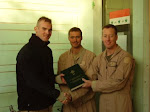 Many of you have lived for years in liturgical "boiling water" and have unwittingly become used to the rising heat, as the increasing "busy-ness" of liturgical action and unwarranted innovations in the liturgy have multiplied exponentially nearly everywhere.
Many of you have lived for years in liturgical "boiling water" and have unwittingly become used to the rising heat, as the increasing "busy-ness" of liturgical action and unwarranted innovations in the liturgy have multiplied exponentially nearly everywhere.What has been lost in the process of the foisting of these distortions upon a largely unsuspecting faithful is very precious: the sense of the real presence of God through the Church's accustomed means of preserving the sacred in the celebration of holy Mass through silence, appropriate sacred music, the unhurried pace of worship and the central role of the priest and other ministers such as deacons and acolytes. If the sense of the presence of God is lost because the liturgy looks more and more like a worldly affair, then the faith of the people is diminished, much like the endangered life of the proverbial frog in water growing increasingly hotter and hotter over time. Many, both ordained and lay, have known for years that something was wrong but perhaps not "what" or "why".
The prefect of the Congregation for Sacred Worship in Rome, or "Culto Divino" in Italian, has forwarded a document passed by its members to the Holy Father for his approval which reinvigorates the mandates of the Second Vatican Council for the liturgy which were lost through the many unauthorized innovations and distortions of the liturgy so widespread and long-standing that many Catholics now mistakenly label them "traditional" and in error have come to believe that they were actually mandated by the Second Vatican Council.
One commentator calls this document, the result of a vote by the dicastery for sacred worship on 12 March and given to the Holy Father on 4 April, the "first concrete movement toward the 'reform of the reform' long hoped-for by Pope Benedict."
He goes on to say, "Almost unanimously the cardinals and bishops members of the Congregation have voted in favor of a greater sacrality of the rite, toward a recovery of the sense of Eucharistic adoration, and a recovery of the Latin language in the celebration and a remaking of part of the introductory rites of the mass to put a stop to abuses, wild experimentations and inopportune creativity. There are also passages favorable to reaffirming the usual mode of receiving communion according to the norms not on the hand but on the tongue. There is, it is true, an indult which permits, upon the request of the episcopates, to distribute the host also upon the palm of the hand, but this needs to remain an extraordinary fact. The 'minister of the liturgy' for Pope Benedict, Archbishop Cañizares, is also going to study the possibility of recuperating the orientation towards the East of the celebrant of Mass at a minimum at the moment of the Eucharistic consecration, as it happened to be practiced before the reform, when the faithful and the priest looked toward the Crucifix and the priest therefore had his back to the assembly." (Source: Il Giornale. Translation from Italian by blog author.)
Note bene: Keep in mind that most of the people, most of the time, have "their backs toward each other" at Mass. There has been simply a choice to focus on the priest, which is an error, and a resulting obsession about which way he is facing during the Mass. This has been a direct result of turning the altar "around", as it were, and requiring the priest and people to face each other during the majority of the celebration of Mass. This was never the universal practice of the Church, was not a mandate of Vatican II, and has had a deleterious effect upon the sense of the sacred and taken away from the centrality of the Lord Who is the real center of our lives and therefore also of our worship.
The essential nature of the liturgy as the movement of the Body of Christ on earth, of all the faithful, priest and people together, toward the Father in the Risen Lord, is the essential work of the Holy Spirit in the Church at prayer. This reality of the identity of the Church is very powerfully and beautifully expressed and manifested by the long-standing practice of the Church in the facing toward liturgical East by both priest and people at certain moments in the liturgy.
For more on the Holy Father's work to "reform the reform" and restore in the holy Mass what was envisioned by the Fathers at the Second Vatican Council, I recommend the more in-depth coverage at Rorate Caeli. Click here to find the story.











No comments:
Post a Comment